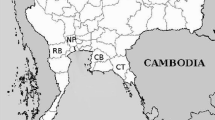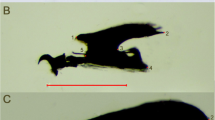Abstract
Biology and maths are usually seen as “poles apart” interests but amalgamated smartly, they create noteworthy findings. The present study deals with the measurement and analysis of six external body parameters of 430 specimens of moths (Lepidoptera: Heterocera) of twenty-one species collected from selected areas of Delhi during 2015–2017 using light traps and opportunistic search. The measured body parts were maximum forewing length, maximum forewing width, maximum thorax width, and body length, and the derived units were body volume and wing surface area. A mathematical tool, coefficient of variance (CV), was applied to deduce the most constant variable among them. As a result, forewing length was found to be the most reliable parameter for taxonomic studies.
Similar content being viewed by others
Suggested Reading
C Parmesan, N Ryrholm, C Stefanescu, J K Hill, C D Thomas, H Descimon, B Huntley, L Kaila, J Kullberg, T Tammaru and W J Tennent, Poleward shifts in geographical ranges of butterfly species associated with regional warming, Nature, Vol.399, No.6736, pp.579, 1999.
K J Gaston, Global patterns in biodiversity, Nature, Vol.405, pp.220–227, 2000.
C A M Van Swaay, Butterfly densities on line transects in The Netherlands from 1990–2001, Entomologische Berichten, Vol.63, No.4, pp.82–87, 2003.
M Cabeza, M B Araújo, R J Wilson, C D Thomas, J R C Matthew and A Moilanen, Combining probabilities of occurrence with spatial reserve design, Journal of Applied Ecology, Vol.41, pp.252–262, 2004.
J F Lamoreux, J C Morrison, T H Ricketts, D M Olson, E Dinerstein, M W McKnight, and H H Shugart, Global tests of biodiversity concordance and the importance of endemism, Nature, Vol.440, pp.212–214, 2006.
S P Venkataramana, Biodiversity and conservation of butterflies in the Eastern Ghats, The Ecoscan, Vol.4, No.1, pp.59–67, 2010.
V Devictor, C Van Swaay, T Brereton, L Brotons, D Chamberlain, J Heliölä and J Reif, Differences in the climatic debts of birds and butterflies at a continental scale, Nature Climate Change, Vol.2, No.2, pp.121, 2012.
T Merkx and E M Slade, Macro moth families differ in their attraction to light: Implications for light trap monitoring programmes, Insect Conservation and Diversity, Vol.7, No.5, pp.453–461, 2014.
E Siemann, D Tilman and J Haarstad, Abundance, diversity, and body size: Patterns from a grassland arthropod community, Journal of Animal Ecology, Vol.68, No.4, pp.824–835, 1999.
J Rydell and W C Lancaster, Flight and thermoregulation in moths were shaped by predation from bats, Oikos, Vol.88, No.1, pp.13–8, 2000.
G Brehm, Diversity of geometrid moths in a montane rainforest in Ecuador, PhD Thesis, Bayreuth University, Germany, pp.197, 2002.
J A Bishop and W S Armbruster, Thermoregulatory abilities of Alaskan bees: Effects of size, phylogeny, and ecology, Functional Ecology, Vol.13, No.5, pp.711–724, 1999.
J T Richtsmeier, V B DeLeon and S R Lele, The promise of geometric morphometrics, American Journal of Physical Anthropology, Vol.45, pp.63–91, 2002.
F J Rohff and L F Marcus, A revolution morphometrics, Trends in Ecology & Evolution, Vol.8, No.4, pp.129–132, 1993.
D C Adams, F J Rohlf and D E Slice, Geometric morphometrics: Ten years of progress following the ‘revolution’, Italian Journal of Zoology, Vol. 71, No.1, pp.5–6, 2004.
M Mutanen and E Pretorius, Subjective visual evaluation vs. traditional and geometric morphometrics in species delimitation: A comparison of moth genitalia, Systematic Entomology, Vol.32, No.2, pp.371–386, 2007.
J G Kingsolver and R B Huey, Size, temperature, and fitness: Three rules, Evolutionary Ecology Research, Vol.10, pp.251–268, 2008.
F Mozaffarian, A Sarafrazi and G N Ganbalani, Host plant-associated population variation in the carob moth Ectomyelois ceratoniae in Iran: A geometric morphometric analysis suggests a nutritional basis, Journal of Insect Science, Vol.7, No.1, pp.2, 2007.
B M Von Reumont, J F Struwe, J Schwarzer and B Misof, Phytogeography of the burnet moth Zygaena transalpina complex: Molecular and morphometric differentiation suggests glacial refugia in Southern France, Western France and micro-refugia within the Alps, Journal of Zoological Systematics and Evolutionary Research, Vol.50, No.1, pp.38–50, 2012.
X Su, X Cai and D Huang, Taxonomic ecology of geometric morphometry on classification and identification of Sphingid moths (Lepidoptera: Sphingidae), Ekoloji, Vol.27, No.106, pp.827–835, 2018.
N Sontigun, C Samerjai, K Sukontason, A Wannasan, J Amendt, J K Tomberlin and K L Sukontason, Wing morphometric analysis of forensically important flesh flies (Diptera: Sarcophagidae) in Thailand, Acta Tropica, Vol.190, pp.312–319, 2019.
G Morge, History of Entomology In Entomology in the Western World in Antiquity and in Medieval Times, Ed. R F Smith, Annual Reviews, Palo Alto, pp.37–80, 1973.
N R Andrew, L Rodgerson and M Dunlop, Variation in invertebrate-bryophyte community structure at different spatial scales along altitudinal gradients, Journal of Biogeography, Vol.30, No.5, pp.731–746, 2003.
C H Schulze, K E Linsenmair and K. Fiedler, Understory versus canopy: Patterns of vertical stratification and diversity among Lepidoptera in a Bornean rain forest, In: Tropical Forest Canopies: Ecology and Management, Eds. K E Davis, A J B Fiala, M R Speight., Vol.69. Springer, Dordrecht, pp.133–152, 2001.
A K Sanyal, Diversity and distribution of moth assemblages along altitudinal gradient in Gangotri landscape, PhD Thesis, Saurashthra University, Rajkot, India, pp.448, 2015.
P A Henderson, Practical Methods in Ecology, Blackwell Publishers, United Kingdom, pp.148, 2005.
Y Shirai, Factors influencing flight ability of male adults of the diamondback moth, Plutella xylostella, with special reference to temperature conditions during the larval stage, Applied Entomology and Zoology, Vol.28, No.3, pp.291–301, 1993.
Y Shirai, Seasonal changes and effect of temperature on flight ability of the diamondback moth, Plutella xylostella (L) (Lepidoptera: Yponomeutidae), Applied Entomology and Zoology, Vol.26, No.1, pp.107–115, 1991.
M Morishita and K Azuma, Effect of temperature on consumption of cabbage leaves by larvae of diamondback moth (Plutella xylostella L.), Japanese Journal of Applied Entomology and Zoology, Vol.34, No.2, pp.169–171, 1990.
R Dudley, The Biomechanics of Insect Flight: Form, Function, Evolution, Princeton University Press, Princeton, New Jersey, pp.425, 2002.
H VanDyck, E Matthysen and A Dhondt, Mate-locating strategies are related to relative body length and wing colour in the speckled wood butterfly Pararge aegeria, Ecological Entomology, Vol.22, No.1, pp.116–120, 1997.
S A Scriven, C M Beale, S Benedick and J K Hill, Barriers to dispersal of rain forest butterflies in tropical agricultural landscapes, Biotropica, Vol.49, No.2, pp.206–216, 2017.
V Debat and P David, Mapping phenotypes: Canalization, plasticity, and developmental stability, Trends in Ecology and Evolution, Vol.16, No.10, pp.555–561, 2001.
D L Stern and D J Emlen, The developmental basis for allometry in insects, Development, Vol.126, No.6, pp.1091–101, 1991.
I D Hodkinson, Terrestrial insects along elevation gradients: species and community responses to altitude, Biological Reviews, Vol.80, No.3, pp.489–513, 2005.
M Paul, Impact of urbanization on moth (Insecta: Lepidoptera: Heterocera) diversity across different urban landscapes of Delhi, India, Acta Ecologica Sinica, Vol.41, No.3, pp.204–209, 2021.
Acknowledgement
The author is grateful to Guru Gobind Singh Indraprastha University, New Delhi, for the financial aid through Indraprastha Research Fellowship (IPRF: File no.1426 dated September 2013). Sincere gratitude is extended towards institutions like the Indian Agricultural Research Institute, Pusa, New Delhi and Delhi University for granting permission to set up light traps in their compounds. The tremendous input of Dr R R. Shashank (IARI, Pusa, New Delhi) on identifying the specimens is highly appreciated. Special thanks to Mr Manish Joshi, Ms Mandeep Kaur, Mr Somnath Sahoo, and Ms Shubhi Malik of Guru Gobind Singh Indraprastha University, New Delhi, for their prompt suggestions towards improving the article.
Author information
Authors and Affiliations
Corresponding author
Additional information
Monalisa Paul holds a PhD in environment management from Guru Gobind Singh Indraprastha University, New Delhi. She is also a senior project associate at CSIR-NIScPR and is associated with an NGO, Envirovigyan, working towards imparting knowledge about environmental issues. Her research focuses on the importance of Lepidoptera (butterflies and moths) and their biotic interactions in the urban landscapes of Delhi, providing insights into the significance of wildlife conservation amidst urbanization.
Rights and permissions
About this article
Cite this article
Paul, M. M3=Maths on Morphometry of Moths. Reson 28, 313–324 (2023). https://doi.org/10.1007/s12045-023-1550-3
Published:
Issue Date:
DOI: https://doi.org/10.1007/s12045-023-1550-3




